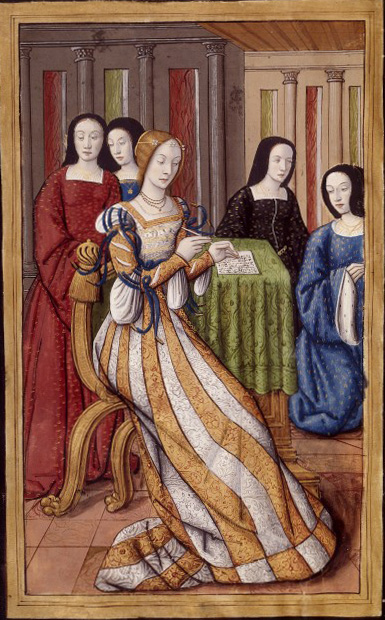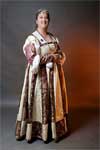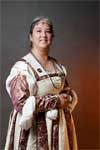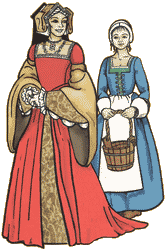Started: September 1, 2010
Ended: October 15, 2010
The Inspiration
 |
 |
 |
 |
 |
 |
 |
 |
 |
|
Construction Photo Gallery Here |
This project was started once I realized I would be attending the Kingdom of Caid's Black Rose Ball, which would have the theme of Field of Cloth of Gold - where King Henry VIII met his brother King, François I of France. This of course meant that the outfit chosen would have to be close to 1520 in time frame, and suitable for a courtier attending this sumptious event. This became even more important once I was asked to be in the fashion show - talk about extra pressure!
The design is inspired by the image known as 'Phyllis Writing' from a manuscript illumination of Heroides, French 874, fol. 11v. Image #3 of 46. Early 16th c. (more info in my blog here.)
The smock
I did first create a smock from hankerchief weight linen from my stash fabrics, but did not document much of the sewing process as the smock was fairly straightforward. Most of the garment is machine sewn, but the neckline was handsewn by simply turning under twice, held down with whip stitches. I added areas of extra buttonhole stitches to strengthed the corners.
The Petticoat
The next layer over the smock is a fitted support bodice with attached skirt, which I consider the petticoat layer. This layer was made from red silk dupioni which I purchased for a low price on eBay. It is interlined in 100% linen French collar canvas purchased from B. Black & Sons. The front has two layers, the back only has a single layer, and the straps were not interlined to allow for more give. To meld the fabrics together, channels were sewn through the interlining and lining materials. The interlining was trimmed from the seam allowance for cleaner turns of the seams. I also offset the fabrics to provide extra fabric for the turn of cloth, which hides the lining from view on the right side.
The biggest changes to this design is that the center front is NOT on a center fold or straight of grain. The grainline is closer to straight along the side seams. The center front actually is curved, which provides more room for my bust than the typical straight front style often seen in modern reproductions. It does appear to be a straight front when laced closed, but this is a visual trick. This is similar to the center front of the extant pair of bodyes worn by Queen Elizabeth I's effigy form, as noted in my recreation of that garment. It is also similar to the Gothic Fitted Dress, a medieval style of garment design described by Robin Netherton
Another change is that the garment originally was designed to not have any boning or support other than the fabric as given. While this did work sufficiently even for my fuller figure, I plan on adding some sort of additional cord or gentle boning into the channels I've already sewn into place.
The Kirtle
The outfit shown in the inspiration image I consider the kirtle layer. The kirtle is made from two matching silk damasks which I had purchased from a discount fabric store in Bakersfield called F&M Fabrics. I had bought the fabrics for my stash, simply because they were too beautiful and inexpensive to pass up. One is in purple and gold, the other in ivory and light gold. While I was sad to cut the fabrics into unidentifiable parts, by random chance, some designs ended up matching in various locations of the skirt.
The kirtle bodice is very similar in pattern to the petticoat bodice, with a few minor adjustments so that the petticoat would not be seen when both garments are worn. The center front overlaps and is held together by hooks and eyes set along the underside edge so that the garment lies flat when closed. Extra pins keep it flat. (Note that most images show the hooks and eyes in a different position than its final positions.)
The kirtle skirt is in a checkboard style, with two color panels alternating, with offset panels at the bottom. Because of the weight of the silk damask, the skirt is mostly unlined. I did add a short panel of cotton flannel at the top to provide some body for the cartridge pleats. The hem is bound in its own fabric, using the reverse side of the purple and gold.
The photo gallery will take you to a photo album of various shots during the construction process. There are images of smock, petticoat, and kirtle, along with more detailed info there for those interested. Additional info can be found in my LiveJournal dress diary entries.
Caid's Arts & Sciences Faire
The outer kirtle won Journeyman First Place, Fiber-Costume Construction, at the Kingdom of Caid's Arts & Sciences Faire and Pentathalon event in March 2011. My documentation file can be found here (pdf 3.5mb) .
 If
you are looking to make your own Henrician Lady/Tudor working class
outfit, I highly recommend using Margo
Anderson's Tudor Lady's Wardrobe pattern, with historical notes
researched by me. If
you are looking to make your own Henrician Lady/Tudor working class
outfit, I highly recommend using Margo
Anderson's Tudor Lady's Wardrobe pattern, with historical notes
researched by me. |
Home
Creative Blog
Kimiko Small Designs
Joan Silvertoppe's SCA Resumé
Warderobe Accounts
Brodyworke Accounts
Scriptor Arts Folium
Tudor Research
Workshops & Articles
Inspiration Gallery
Largesse
Favorite Links
About Me
Contact Me
http://www.kimiko1.com
Entire website, graphics, and text (unless otherwise stated)
© 2003-2013 Kimiko Small, All Rights Reserved


